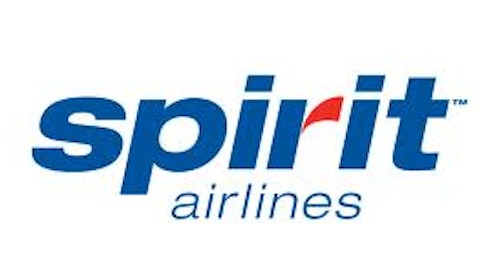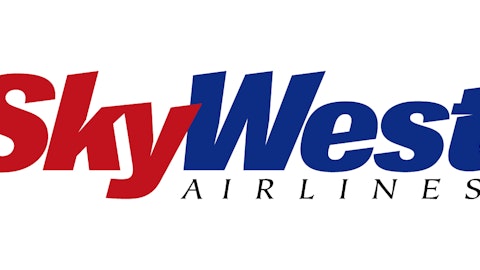The most prominent of these carriers is JetBlue Airways Corporation (NASDAQ:JBLU). The New York-based airline has for years been capturing market share from legacy airlines on intra-U.S. flights. More recently, it has expanded to become the largest airline in Boston, while also flying more than 25% of its capacity to Caribbean destinations, primarily Puerto Rico.
Its sales growth rates, 9.97% on average over the past five years, and gross margins, 46.30% for the trailing 12 months, are regularly above that of the broader industry, (7.84% and 39.00% respectively). This indicates that JetBlue Airways Corporation (NASDAQ:JBLU) has expanded rapidly, while still maintaining a strong level of profitability. Its point-to-point route network inherently carries better margins than hub-and-spoke model airlines, because of the lower-cost structure.
JetBlue should maintain these advantages as it boosts its level of business flying in Boston, thus lifting the average airfare, and helping revenue per available seat mile, or RASM, to remain strong. This belief is founded on its strategy of focusing on higher-margined flights and geographical markets.
I like JetBlue shares for their three to five-year price appreciation potential, as the company plans to expand. This year alone, it is entering markets such as Charleston, Albuquerque, Philadelphia, and Medellin, Colombia.
The largest domestic airline, United Continental Holdings Inc (NYSE:UAL), is aiming to be one of the most efficient in terms of filling aircraft and keeping its cost per available seat mile, or CASM, at profitable levels.
The carrier is, in fact, achieving increased earnings this year, despite lower capacity and passenger enplanements. This has been partly a result of increased load factors (fuller aircraft), as well as reduced fuel costs. Up until earlier this year, it did not make major increases to its fleet, and a greater overall numbers of air travelers has helped to drive up its load factors.
United Continental Holdings Inc (NYSE:UAL), earlier this year, chose to improve the productivity of its aircraft fleet when it ordered new, more fuel-efficient planes. The integration of Continental, an acquisition made in 2010, is near completion, and seems to be resulting in better productivity.
As such, the carrier is on pace for a near doubling of EPS this year, should conditions (economy and jet fuel prices) hold stable.
United Continental’s stock is worth a look for long-term upside. For the reasons stated, its volatility had been reduced substantially, as seen by its beta of 0.78 as compared against the industry average of 1.18.
Where to invest
The most enticing investment is United Continental, trading at a forward P/E of 6.0. The stock of the other major international carrier, Delta Air Lines, Inc. (NYSE:DAL), is also one investors ought to consider for their portfolios. See “Your Guide to International Airline Expansion” for more on why these legacy carriers hold promise.
In terms of the other two, Southwest Airlines Co. (NYSE:LUV) and JetBlue, the growing leisure air travel market ought to work to their advantage. More consumers are choosing point-to-point short-haul flights, and these are two of the largest providers of that service.
The article Why to Invest in Airline Stocks originally appeared on Fool.com and is written by Damon Churchwell.
Damon Churchwell has no position in any stocks mentioned. The Motley Fool recommends Southwest Airlines.
Copyright © 1995 – 2013 The Motley Fool, LLC. All rights reserved. The Motley Fool has a disclosure policy.





